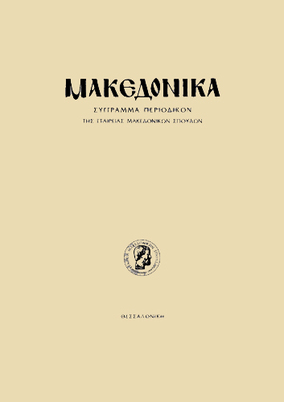Παραλειπόμενα του Μακεδονικού Αγώνα από το αρχείο Παύλου & Ναταλίας Μελά
Part of : Μακεδονικά ; Vol.33, 2002, pages 141-160
Issue:
Pages:
141-160
Parallel Title:
Omissions about the Struggle for Macedonia from the Files of Pavlos and Natalia Mela
Section Title:
Articles
Abstract:
From the section of the file of Pavlos and Natalia Mela that is kept in the Hellenic Literary and Historical Archive (E.L.I.A.) a cryptographic code of communication is presented, used by the secretary of the Hellenic Consulate General at Monastir (today’s Vitola), Ion Dragoumis, through five leaves (pages) of handwritten receipts of payment of pecuniary sums for the needs of the national struggle for Macedonia. These receipts, which have been signed to Ion Dragoumis by the recipi ents of money, include footnotes by him written in cryptographic code, which explain the real reason for the disposal of particular pecuniary sum. These five receipts have been deposited between April 12th and April 30th, 1903. The cryptographic code is based on the Latin alphabet. It uses letters from the aforementioned alphabet that replace all the letters of the Hellenic alphabet, as well as the diphthongs. The same section of the file contains a handwritten “statistical name-plate of Greek34 Orthodox schools of [the village] Emborion and the vicinity” for the school year 1902-1903, that is written and signed by a teacher, named Ilias Dimitrios Bouziotis from Kastoria. As its date of writing Bouziotis reports March 25th, 1903 and the stat istical name-plate is composed of sixteen pages of recordings. The regions that the table refer to are: Emborion, Paleochorion, Langa, Durutlar, Frangots, Trebenon, Komanon, Trepista, Hasanköy that were inside the limits of the sub-district of Kayalar (Kayalar kazasi) in the administrative district of Ser- fitze (Serfice sancagi). Brancoff D. M. in his book La Macédoine et sa Population Chrétienne (1905) classifies the sub-district of Kayalar as one of the regions where the Bulgarian element predominates demographically. The book’s references alleged that according to official Bulgarian data [statistics of the Bulgarian Exarchic (schismatic) Church], in the Emborion village two Bulgarian schools existed with 69 students, in the Paleochorion village a public school with 109 students and in the Trepista village a public school with 33 students, while in the Devri village functioned a Bulgarian elementary school with 69 students, ignoring (?) the existence of the aforementioned Greek Orthodox schools.
Subject:
Subject (LC):
Notes:
856:https://ejournals.epublishing.ekt.gr/index.php/makedonika/article/view/5844, DOI: https://doi.org/10.12681/makedonika.283
Electronic Resources:




